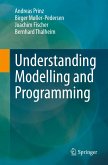This book fills a serious gap by providing a conceptual framework for understanding the digital world. This world contains large, heterogeneous systems that have to manage dynamic behavior as well as static items and data. Obviously, new, digital methods are needed to deal with the challenges of the digital world.
This book introduces such a method with Heraklit, an intuitively simple, albeit powerful framework for modeling, communicating, and analyzing computer-integrated systems. It integrates proven methods for composing modules, describing behavior with local cause and effect, and digitally representing real- and imagined-world items, resulting in a comprehensive, expressive, concerted, technically simple, digital modeling method.
This book is structured according to three Heraklit pillars, starting in Part I with the central Heraklit concept of modules, in particular their composition and refinement. Part II covers the second pillar of Heraklit, dynamics, focusing on modules that describe aspects of behavior. Part III focuses on static aspects. In particular, real- and imagined-world items and their symbolic representation are carefully distinguished and related. Together, these three pillars are consolidated in Part IV, integrating all concepts into a powerful formal framework. The book concludes in Part V with a more comprehensive case study of a typical retail business, recommendations on how to start modeling with Heraklit, and useful graphical conventions for the graphical representation of Heraklit models.
Heraklit covers the range from the first informal structuring ideas for a computer-integrated system, through the specification of (business) processes, the contributions of people, organizations, and mechanical devices, up to the construction of software. The book is therefore written for students in areas related to system modeling, system design, and system engineering, as well as for professionals in these fields.
This book introduces such a method with Heraklit, an intuitively simple, albeit powerful framework for modeling, communicating, and analyzing computer-integrated systems. It integrates proven methods for composing modules, describing behavior with local cause and effect, and digitally representing real- and imagined-world items, resulting in a comprehensive, expressive, concerted, technically simple, digital modeling method.
This book is structured according to three Heraklit pillars, starting in Part I with the central Heraklit concept of modules, in particular their composition and refinement. Part II covers the second pillar of Heraklit, dynamics, focusing on modules that describe aspects of behavior. Part III focuses on static aspects. In particular, real- and imagined-world items and their symbolic representation are carefully distinguished and related. Together, these three pillars are consolidated in Part IV, integrating all concepts into a powerful formal framework. The book concludes in Part V with a more comprehensive case study of a typical retail business, recommendations on how to start modeling with Heraklit, and useful graphical conventions for the graphical representation of Heraklit models.
Heraklit covers the range from the first informal structuring ideas for a computer-integrated system, through the specification of (business) processes, the contributions of people, organizations, and mechanical devices, up to the construction of software. The book is therefore written for students in areas related to system modeling, system design, and system engineering, as well as for professionals in these fields.








